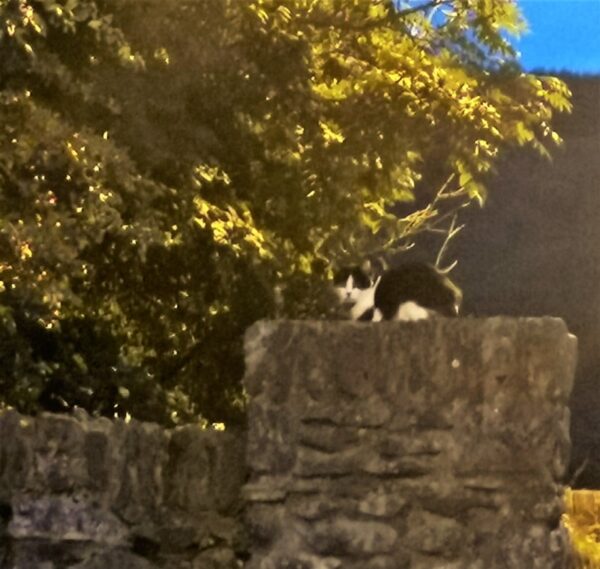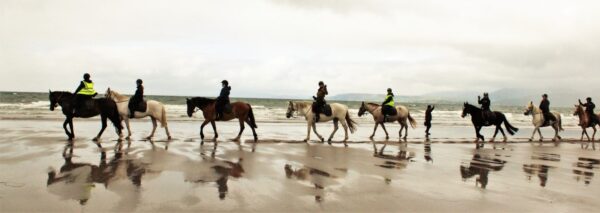 Dia is Mhuire díobh go léir a chairde, and welcome to my weekly report.
Dia is Mhuire díobh go léir a chairde, and welcome to my weekly report.
According to the books the months of Autumn are September, October and November but the changes of our climate disagrees in part at least with that as the season of autumn is well on it’s way even though we are only in the middle on August. August as we knew it was a month full of promise, the time when we looked forward to reaping the fruits of our labour. A time to wonder through the fields and admire the crops now coming into harvest time. Some have the hay already safely tucked away in sheds or reeks, acres of grain not ready just yet. I would follow my Dad around the headlands in the evening after milking time, being the youngest, he would take me with him to keep me out of trouble or danger and as we would amble along he would run his hand with pride along the long laces take a grain of oats from a stalk, remove the outer covering and put it between his teeth, this was the test it to see if it was solid and ripe enough to be cut. The same went for the barley or wheat. Any evidence of a milky residue, proved it wasn’t ready yet. By this time to whole seen would have changed from a mass glossy green to a rich golden hue the barley especially standing out in the gentle breezes with its whiskers giving a sleek velvety appearance to the scene. As with most things of the land it was a very worrying time. Grain being a very vulnerable crop. There was little choice or opportunity to get it saved from the elements. Sometimes it became victim to high winds and heavy rains and where perhaps a field of hay would get a second chance, it was not so with grain. Lodged corn was the nightmare of every grain grower. Once down it was a free for all in the bird world. Crows, pigeons, seagulls seemed to send out the word that it was feeding time in the grain world. It was up to the farmer to apply his art to try a fend them off in order to salvage some degree of his precious crop from their hungry jaws/beaks. Some were fortunate to have a licenced gun and spared no effort in letting them have pellets in full blast to either kill of ward them off. To capture a dead crow, was to have a prize possession. Their remains hung up in the troubled area to let others crows know they were entering a danger zone and kept other members of the species at bay. Not being armed with gun-power the farmer had to resort to his own artful talent to save his property. Enter the scarecrow. For those who had nothing to lose to the bird invasion, the scarecrow provided a prolonged exhibition of rural talent as they drove the highways and byways of the countryside at that time of year. All manner of ensemble(s) was used. Colour was paramount or at least the variety of. Himself frustrated by the threat to his livelihood would storm into the kitchen, demanding castoffs from the wife while he went outside to make a strong framework to place in his field, and the sooner the better. All this time while his plan was in the making, the crows were enjoying his grain. Joining him in the yard, the longsuffering wife arrived with a multicoloured supply of the oldest drapery that she could find. Her most gaudy dresses that she had on at countless weddings and funerals and Holy Communions and Confirmations for longer than she care to recall. Then his own well worn colourful handknit gansies and that old Sunday coat that no longer fits. He wouldn’t let it go if it did. But to top it all there was Granda’s battered old hat and scarf. Out on the lodged patch the combined effort of man and wife busied themselves to construct a never-before seen sculp, impressive enough to set the marauding insurgents to ask themselves if it was alive or not. Many of these inventions did work admirably but alas others became utter disappointments when despite all their scariness the offending rooks were seen to land atop of them for a better view of the place around. At least it provided many a good picture of rural Ireland for tourists to send to their folks at home. But thanks to Mother Nature the crops did ripen eventually and the hard manual work to save them began. In the pre-tractor days it was done by horse and man/woman power. The old Pierse mowing machine which was still in the corner of some field since the cutting of the hay was once again brought into action. This time a special crib was fitted to the cutting bar for making sheaves and a second seat was fitted for a driver. From an early age this was my job, to drive the pair of horses while my Dad armed with a hand rake used the crib to divide the falling corn into matching bundles. It was the case of all hands on deck then when these bundles were gathered up a bound into neat sheaves and put aside until all was done. At the completion of the task these sheaves were collected and every six or eight of them were stood up against each other to form a stook and left for a week or more to further dry in the sun. There was no spraying of any kind for weeds or thistles or docks so the presence of them was quiet common and they posed a painful problem for workers. At the end of the day there was often a few thorns to be picked. It was such a common problem that most people came prepared. Most men kept a headpin stuck in at the point of the lapel of their coat where it was at the ready to remove and painful thorn or splinter. Some thorns were regarded as being quiet dangerous causing blood poisoning and even death in some cases. I’m not sure if I’m right but I think that the thorn of a whitethorn bush in Springtime when it’s starting to green up after the winter was supposed to be one of the greatest offenders and led to the demise of some unlucky people when treatment for blood poisoning wasn’t still discovered. When conditions were right the months of July and August were good ones for wild mushrooms. But we didn’t call them wild mushrooms back then. They were the only ones we had. The clammy mild weather at that time of year seemed right for them. And what a novelty it was to find some their creamy white heads bursting up through the grass. Some years were better than others, and when there was a bumper crop I heard of people making mushroom ketchup. Above all not any were wasted. There was something magical about mushrooms back then. You could search without luck at a certain time, come back an hour or so later and be lucky. They seemed to spring up and open like an umbrella. Some fields were better than others and how we combed the best places in the dear hope of arriving home with even a few. Sometimes the snail or crow, beat you to it ,but not always. There was never enough to make a meal of them, just shake a little salt and stand it on the hot range, until it changed colour and filled up with succulent juice, then in one go, into the mouth for a God-given treat. The flavour was unique. With the development of a thriving mushroom industry, we can all enjoy them today in many forms. I have never lost my respect or admiration for them and even though they don’t taste the same, the look of them alone, takes me back.
[read more …] “Eily’s Report – 17th August”












 Dia is Mhuire díobh go léir a chairde, and welcome to my weekly report.
Dia is Mhuire díobh go léir a chairde, and welcome to my weekly report.